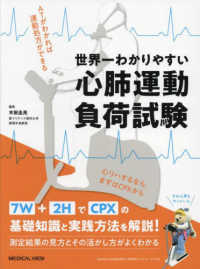- ホーム
- > 洋書
- > 英文書
- > Cinema / Film
Full Description
Re-Viewing the Past: The Uses of History in the Cinema of Imperial Japan analyzes the complicated relationship between history films, audiences, reviewers and censors in Japan for the critically important years from 1925-1945. First contextualizing the history of the popular "Bakumatsu" period (1853-1868), the moment of Japan's emergence as a modern nation, Sean O'Reilly paves the way for a reinterpretation of Japanese pre and postwar cinema. Setting a film in the Bakumatsu period offered 'cultural breathing room' to both filmmakers and viewers, offering a cinematic space where apolitical entertainment and now-forbidden themes like romance still reigned. Some filmmakers—and viewers—even conceived of these films as being a form of resistance against Japan's growing militarism.
As comparisons between the popularity of such films versus that of state-sponsored propaganda films show, audiences responded enthusiastically to these glimmers of resistance. O'Reilly argues that we should turn our attention to the much more popular films of the time that were major hits with audiences in order to understand what resonated with wartime spectators, and to speculate about why this might have been the case. Including clips of these rare films, a so-far neglected area of Japanese film history is now firmly situated in context to offer a thought-provoking, multidisciplinary approach.
Contents
1. Introduction
2. Valorizing the Villains: the First Bakumatsu Boom and 1927's Sonno joi
3. History as Nonsense: Historical Parodies of the Bakumatsu
4. Serial History: the Case of Kurama Tengu
5. Consuming History, Hating the Enemy
6. Romancing History
7. Transwar Japan
Bibliography
Index







